coolant temperature SUZUKI JIMNY 2020 Owners Manual
[x] Cancel search | Manufacturer: SUZUKI, Model Year: 2020, Model line: JIMNY, Model: SUZUKI JIMNY 2020Pages: 421, PDF Size: 6.35 MB
Page 119 of 421
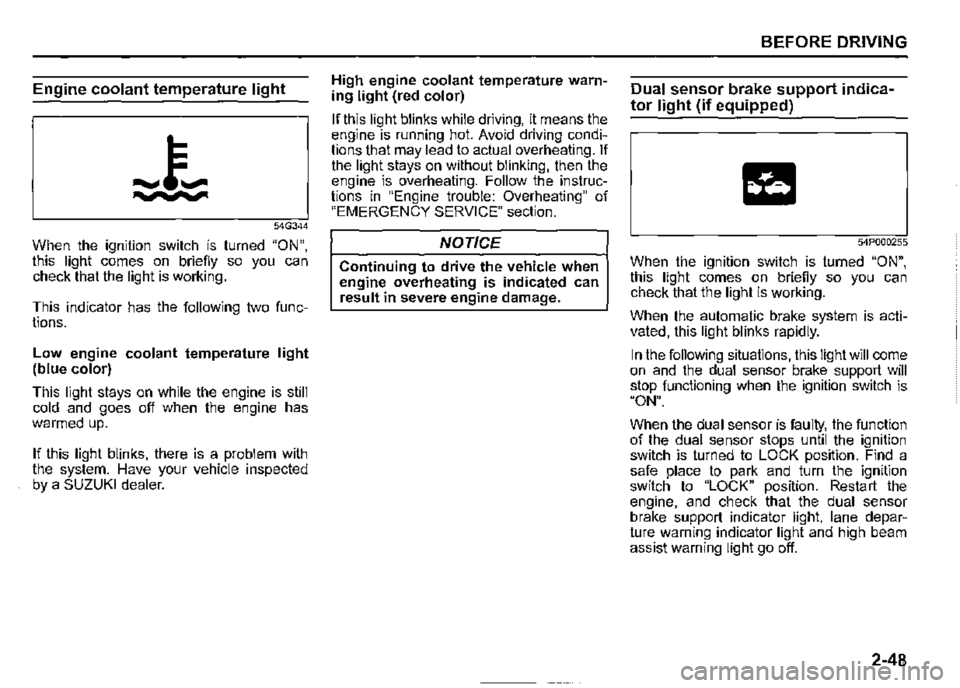
Engine coolant temperature light
54G344
When the ignition switch is turned "ON", this light comes on briefly so you can check that the light is working.
This indicator has the following two functions.
Low engine coolant temperature light (blue color)
This light stays on while the engine is still cold and goes off when the engine has warmed up.
If this light blinks, there is a problem with the system. Have your vehicle inspected by a SUZUKI dealer.
High engine coolant temperature warning light (red color)
If this light blinks while driving, it means the engine is running hot. Avoid driving conditions that may lead to actual overheating. If the light stays on without blinking, then the engine is overheating. Follow the instructions in "Engine trouble: Overheating" of "EMERGENCY SERVICE" section.
NOTICE
Continuing to drive the vehicle when engine overheating is indicated can result in severe engine damage.
BEFORE DRIVING
Dual sensor brake support indica
tor light (if equipped)
54P000255
When the ignition switch is turned "ON", this light comes on briefly so you can check that the light is working.
When the automatic brake system is activated, this light blinks rapidly.
In the following situations, this light will come on and the dual sensor brake support will stop functioning when the ignition switch is "ON".
When the dual sensor is faulty, the function of the dual sensor stops until the ignition switch is turned to LOCK position. Find a safe place to park and turn the ignition switch to "LOCK" position. Restart the engine, and check that the dual sensor brake support indicator light, lane departure warning indicator light and high beam assist warning light go off.
2-48
Page 147 of 421
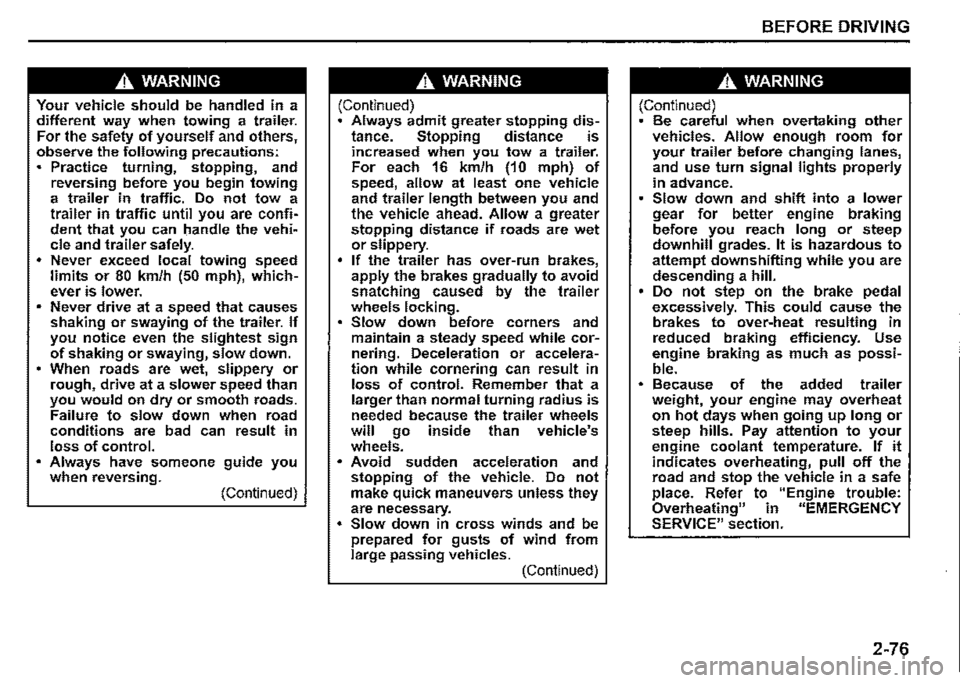
A WARNING
Your vehicle should be handled in a different way when towing a trailer. For the safety of yourself and others, observe the following precautions: Practice turning, stopping, and reversing before you begin towing a trailer in traffic. Do not tow a trailer in traffic until you are confident that you can handle the vehicle and trailer safely. Never exceed local towing speed limits or 80 km/h (50 mph), whichever is lower. Never drive at a speed that causes shaking or swaying of the trailer. If you notice even the slightest sign of shaking or swaying, slow down. • When roads are wet, slippery or rough, drive at a slower speed than you would on dry or smooth roads. Failure to slow down when road conditions are bad can result in loss of control. Always have someone guide you when reversing. (Continued)
A WARNING
(Continued) Always admit greater stopping distance. Stopping distance is increased when you tow a trailer. For each 16 km/h (10 mph) of speed, allow at least one vehicle and trailer length between you and the vehicle ahead. Allow a greater stopping distance if roads are wet or slippery. If the trailer has over-run brakes, apply the brakes gradually to avoid snatching caused by the trailer wheels locking. Slow down before corners and maintain a steady speed while cornering. Deceleration or acceleration while cornering can result in loss of control. Remember that a larger than normal turning radius is needed because the trailer wheels will go inside than vehicle's wheels. Avoid sudden acceleration and stopping of the vehicle. Do not make quick maneuvers unless they are necessary. Slow down in cross winds and be prepared for gusts of wind from large passing vehicles. (Continued)
BEFORE DRIVING
A WARNING
(Continued) Be careful when overtaking other vehicles. Allow enough room for your trailer before changing lanes, and use turn signal lights properly in advance. Slow down and shift into a lower gear for better engine braking before you reach long or steep downhill grades. It is hazardous to attempt downshifting while you are descending a hill. Do not step on the brake pedal excessively. This could cause the brakes to over-heat resulting in reduced braking efficiency. Use engine braking as much as possible. Because of the added trailer weight, your engine may overheat on hot days when going up long or steep hills. Pay attention to your engine coolant temperature. If it indicates overheating, pull off the road and stop the vehicle in a safe place. Refer to "Engine trouble: Overheating" in "EMERGENCY SERVICE" section.
2-76
Page 345 of 421
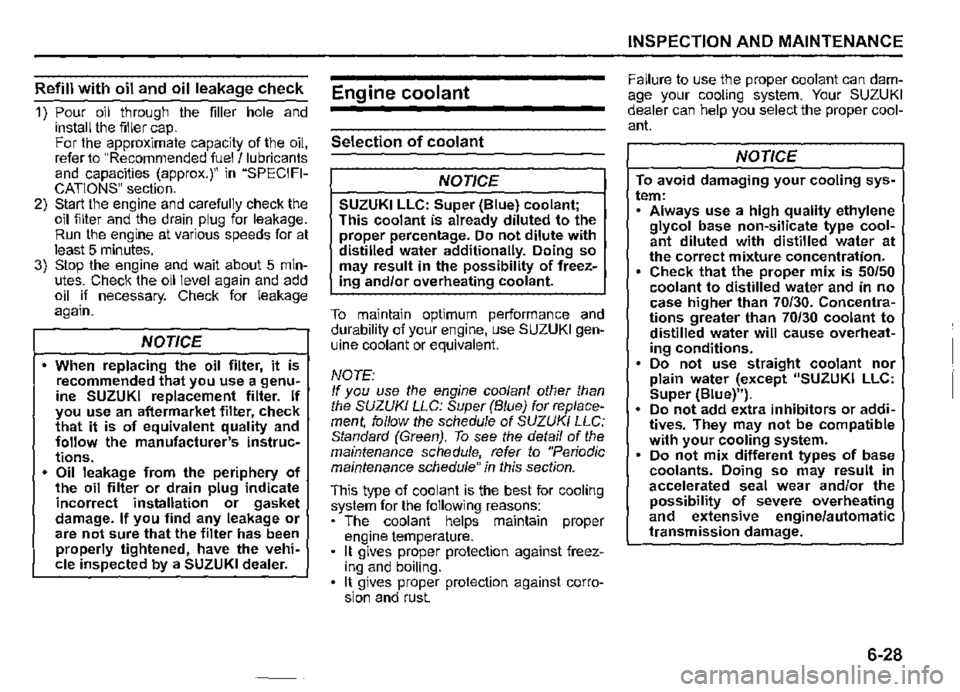
Refill with oil and oil leakage check
1) Pour oil through the filler hole and install the filler cap. For the approximate capacity of the oil, refer to "Recommended fuel / lubricants and capacities (approx.)" in "SPECIFICATIONS" section. 2) Start the engine and carefully check the oil filter and the drain plug for leakage. Run the engine at various speeds for at least 5 minutes. 3) Stop the engine and wait about 5 minutes. Check the oil level again and add oil if necessary. Check for leakage again.
NOTICE
When replacing the oil filter, it is recommended that you use a genuine SUZUKI replacement filter. If you use an aftermarket filter, check that it is of equivalent quality and follow the manufacturer's instructions. • Oil leakage from the periphery of the oil filter or drain plug indicate incorrect installation or gasket damage. If you find any leakage or are not sure that the filter has been properly tightened, have the vehicle inspected by a SUZUKI dealer.
Engine coolant
Selection of coolant
NOTICE
SUZUKI LLC: Super (Blue) coolant; This coolant is already diluted to the proper percentage. Do not dilute with distilled water additionally. Doing so may result in the possibility of freezing and/or overheating coolant.
To maintain optimum performance and durability of your engine, use SUZUKI genuine coolant or equivalent.
NOTE: If you use the engine coolant other than the SUZUKI LLC: Super (Blue) for replacement, follow the schedule of SUZUKI LLC: Standard (Green). To see the detail of the maintenance schedule, refer to "Periodic maintenance schedule" in this section.
This type of coolant is the best for cooling system for the following reasons: • The coolant helps maintain proper engine temperature. It gives proper protection against freezing and boiling. It gives proper protection against corrosion and rust.
INSPECTION AND MAINTENANCE
Failure to use the proper coolant can damage your cooling system. Your SUZUKI dealer can help you select the proper coolant.
NOTICE
To avoid damaging your cooling system: Always use a high quality ethylene glycol base non-silicate type coolant diluted with distilled water at the correct mixture concentration. Check that the proper mix is 50/50 coolant to distilled water and in no case higher than 70/30. Concentrations greater than 70/30 coolant to distilled water will cause overheating conditions. Do not use straight coolant nor plain water (except "SUZUKI LLC: Super {Blue)"). . • Do not add extra inhibitors or additives. They may not be compatible with your cooling system. Do not mix different types of base coolants. Doing so may result in accelerated seal wear and/or the possibility of severe overheating and extensive engine/automatic transmission damage.
6-28
Page 346 of 421
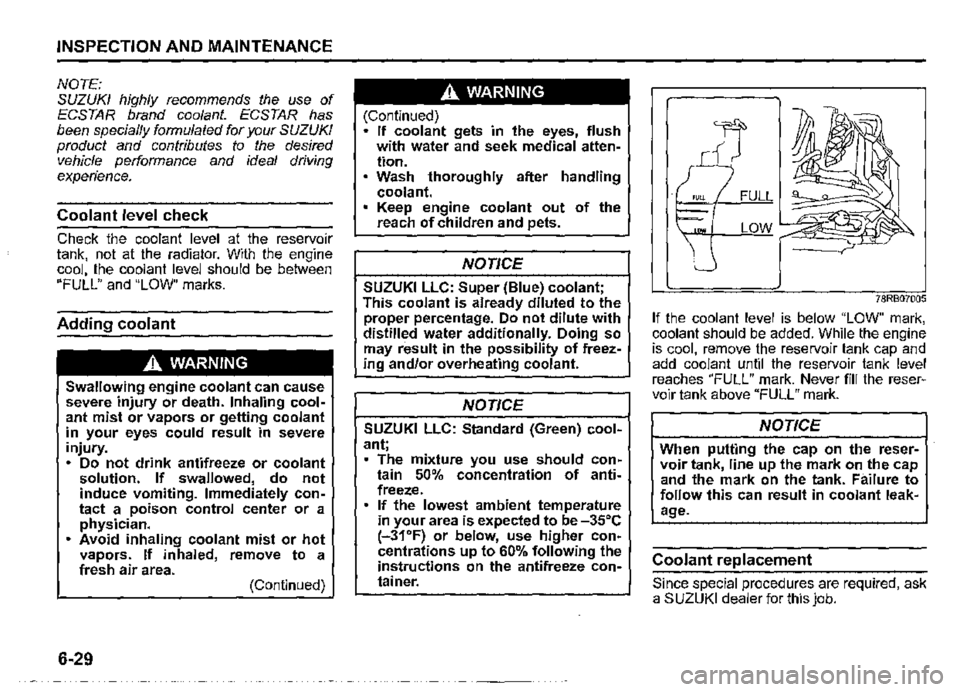
INSPECTION AND MAINTENANCE
NOTE: SUZUKI highly recommends the use of ECSTAR brand coolant. ECSTAR has been specially formulated for your SUZUKI product and contributes to the desired vehicle performance and ideal driving experience.
Coolant level check
Check the coolant level at the reservoir tank, not at the radiator. With the engine cool, the coolant level should be between "FULL" and "LOW" marks.
Adding coolant
,A WARNING
Swallowing engine coolant can cause severe injury or death. Inhaling coolant mist or vapors or getting coolant in your eyes could result in severe injury. • Do not drink antifreeze or coolant solution. If swallowed, do not induce vomiting. Immediately contact a poison control center or a physician. • Avoid inhaling coolant mist or hot vapors. If inhaled, remove to a fresh air area. (Continued)
6-29
,A WARNING
(Continued) • If coolant gets in the eyes, flush with water and seek medical attention. Wash thoroughly after handling coolant. Keep engine coolant out of the reach of children and pets.
NOTICE
SUZUKI LLC: Super (Blue) coolant; This coolant is already diluted to the proper percentage. Do not dilute with distilled water additionally. Doing so may result in the possibility of freezing and/or overheating coolant.
NOTICE
SUZUKI LLC: Standard (Green) coolant; • The mixture you use should contain 50% concentration of antifreeze. If the lowest ambient temperature in your area is expected lo be -35°C (-31'F) or below, use higher concentrations up to 60% following the instructions on the antifreeze container.
78RB07005
If the coolant level is below "LOW" mark, coolant should be added. While the engine is cool, remove the reservoir tank cap and add coolant until the reservoir tank level reaches "FULL" mark. Never fill the reservoir tank above "FULL" mark.
NOTICE
When putting the cap on the reservoir tank, line up the mark on the cap and the mark on the tank. Failure to follow this can result in coolant leakage.
Coolant replacement
Since special procedures are required, ask a SUZUKI dealer for this job.
Page 387 of 421
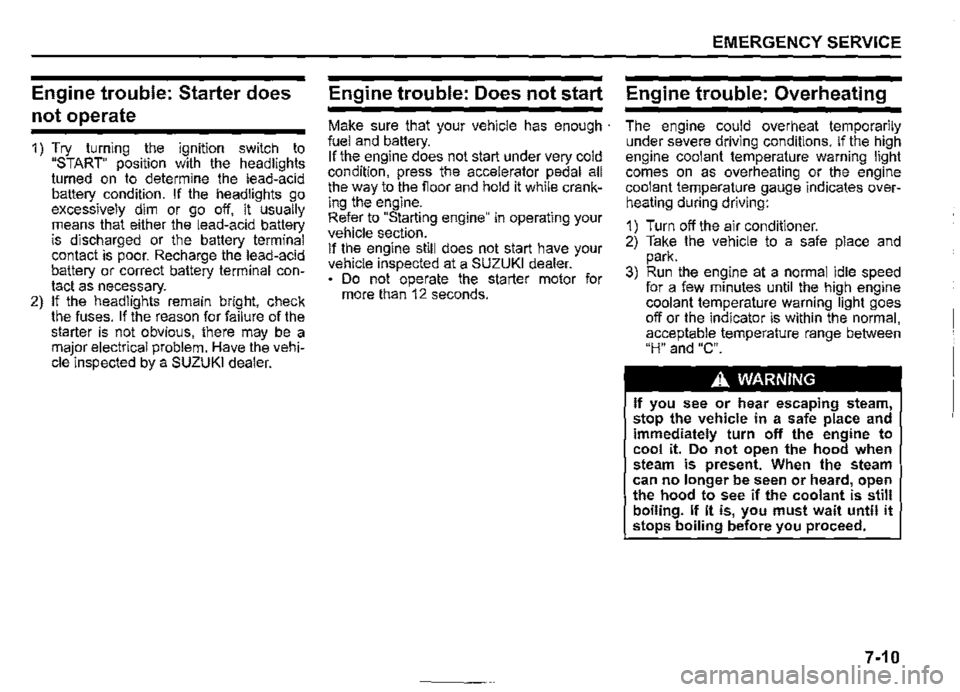
Engine trouble: Starter does
not operate
1) Try turning the ignition switch to "START" position with the headlights turned on to determine the lead-acid battery condition. If the headlights go excessively dim or go off, it usually means that either the lead-acid battery is discharged or the battery terminal contact is poor. Recharge the lead-acid battery or correct battery terminal contact as necessary. 2) If the headlights remain bright, check the fuses. If the reason for failure of the starter is not obvious, there may be a major electrical problem. Have the vehicle inspected by a SUZUKI dealer.
Engine trouble: Does not start
Make sure that your vehicle has enough · fuel and battery. If the engine does not start under very cold condition, press the accelerator pedal all the way to the fioor and hold it while cranking the engine. Refer to "Starting engine" in operating your vehicle section. If the engine still does not start have your vehicle inspected at a SUZUKI dealer. Do not operate the starter motor for more than 12 seconds.
EMERGENCY SERVICE
Engine trouble: Overheating
The engine could overheat temporarily under severe driving conditions. If the high engine coolant temperature warning light comes on as overheating or the engine coolant temperature gauge indicates overheating during driving:
1) Turn off the air conditioner. 2) Take the vehicle to a safe place and park. 3) Run the engine at a normal idle speed for a few minutes until the high engine coolant temperature warning light goes off or the indicator is within the normal, acceptable temperature range between "H" and "C".
A WARNING
If you see or hear escaping steam, stop the vehicle in a safe place and immediately turn off the engine to cool it. Do not open the hood when steam is present. When the steam can no longer be seen or heard, open the hood to see if the coolant is still boiling. If it is, you must wait until it stops boiling before you proceed.
7-10
Page 388 of 421
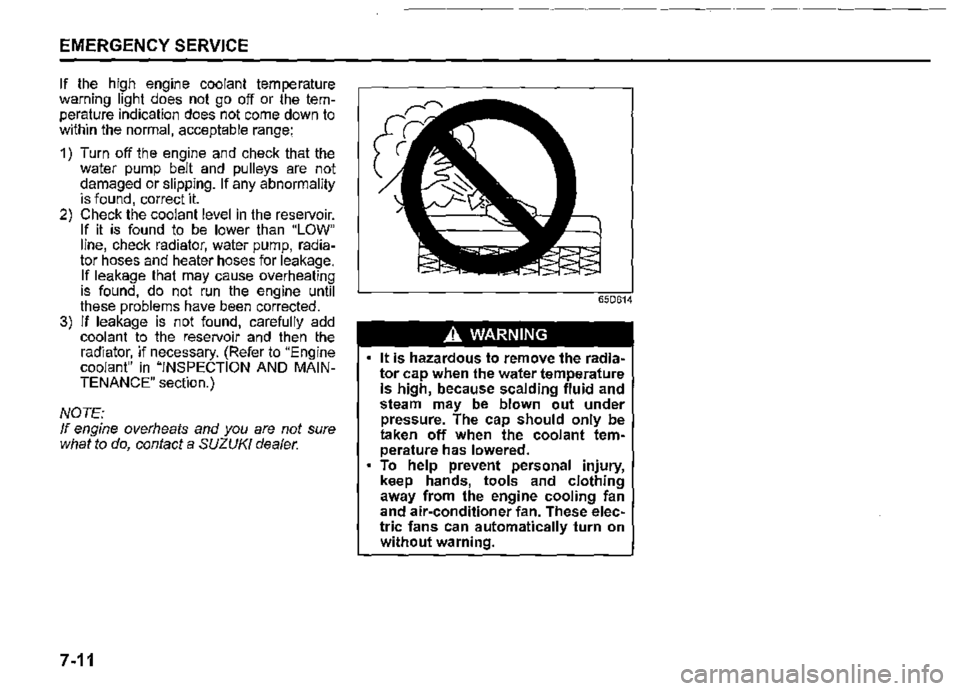
EMERGENCY SERVICE
If the high engine coolant temperature warning light does not go off or the temperature indication does not come down to within the normal, acceptable range:
1) Turn off the engine and check that the water pump belt and pulleys are not damaged or slipping. If any abnormality is found, correct it. 2) Check the coolant level in the reservoir. If it is found to be lower than "LOW" line, check radiator, water pump, radiator hoses and heater hoses for leakage. If leakage that may cause overheating is found, do not run the engine until these problems have been corrected. 3) If leakage is not found, carefully add coolant to the reservoir and then the radiator, if necessary. (Refer to "Engine coolant" in "INSPECTION AND MAINTENANCE" section.)
NOTE: If engine overheats and you are not sure what to do, contact a SUZUKI dealer.
7-11
650614
A WARNING
• It is hazardous to remove the radiator cap when the water temperature is high, because scalding fluid and steam may be blown out under pressure. The cap should only be taken off when the coolant temperature has lowered. To help prevent personal injury, keep hands, tools and clothing away from the engine cooling fan and air-conditioner fan. These electric fans can automatically turn on without warning.
Page 412 of 421
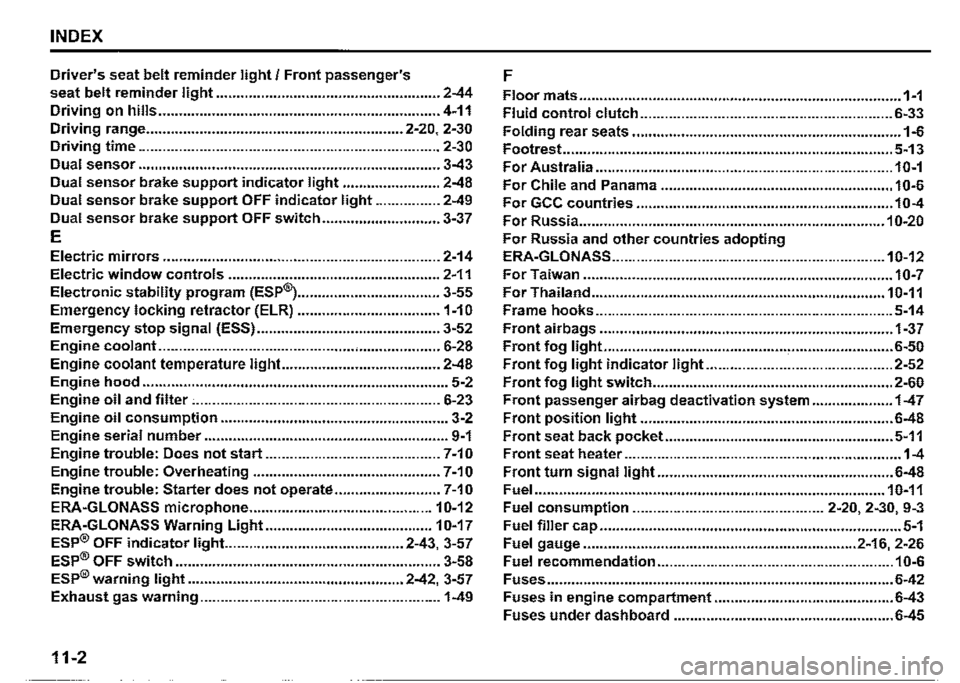
INDEX
Driver's seat belt reminder light/ Front passenger's F seat belt reminder light ....................................................... 2-44 Floor mats ............................................................................... 1-1 Driving on hills ..................................................................... 4-11 Fluid control clutch .............................................................. 6-33 Driving range ............................................................... 2-20, 2-30 Folding rear seats .................................................................. 1-6 Driving time .......................................................................... 2-30 Footrest ................................................................................. 5-13 Dual sensor .......................................................................... 3-43 For Australia ......................................................................... 10-1 Dual sensor brake support indicator light ........................ 2-48 For Chile and Panama ......................................................... 10-6 Dual sensor brake support OFF indicator light ................ 2-49 For GCC countries ............................................................... 10-4 Dual sensor brake support OFF switch ............................. 3-37 For Russia ........................................................................... 10-20
E For Russia and other countries adopting
Electric mirrors .................................................................... 2-14 ERA-GLONASS ................................................................... 10-12
Electric window controls .................................................... 2-11 For Taiwan ............................................................................ 10-7
Electronic stability program (ESP®) ................................... 3-55 For Thailand ........................................................................ 10-11
Emergency locking retractor (ELR) ..................................• 1-1 O Frame hooks ......................................................................... 5-14
Emergency stop signal (ESS) ............................................. 3-52 Front airbags ........................................................................ 1-37
Engine coolant ..................................................................... 6-28 Front fog light ............................................. , ......................... 6-50
Engine coolant temperature light ....................................... 2-48 Front fog light indicator light .............................................. 2-52
Engine hood ........................................................................... 5-2 Front fog light switch ........................................................... 2-60
Engine oil and filter , ............................................................ 6-23 Front passenger airbag deactivation system .................... 1-47
Engine oil consumption ........................................................ 3-2 Front position light .............................................................. 6-48
Engine serial number ............................................................ 9-1 Front seat back pocket ........................................................ 5-11
Engine trouble: Does not start ........................................... 7-10 Front seat heater .................................................................... 1-4
Engine trouble: Overheating .............................................. 7-1 O Front turn signal light .......................................................... 6-48
Engine trouble: Starter does not operate .......................... 7-10 Fuel ...................................................................................... 10-11
ERA-GLONASS microphone ............................................. 10-12 Fuel consumption ............................................... 2-20, 2-30, 9-3
ERA-GLONASS Warning Light ......................................... 10-17
ESP® OFF indicator light. ........................................... 2-43, 3-57
ESP® OFF switch ................................................................. 3-58
Fuel filler cap .......................................................................... 5-1
Fuel gauge ................................................................... 2-16, 2-26
Fuel recommendation .......................................................... 10-6
ESP® warning light ..................................................... 2-42, 3-57 Fuses ..................................................................................... 6-42
Exhaust gas warning ........................................................... 1-49 Fuses in engine compartment ............................................ 6-43
Fuses under dashboard ...................................................... 6-45
11-2
Page 413 of 421
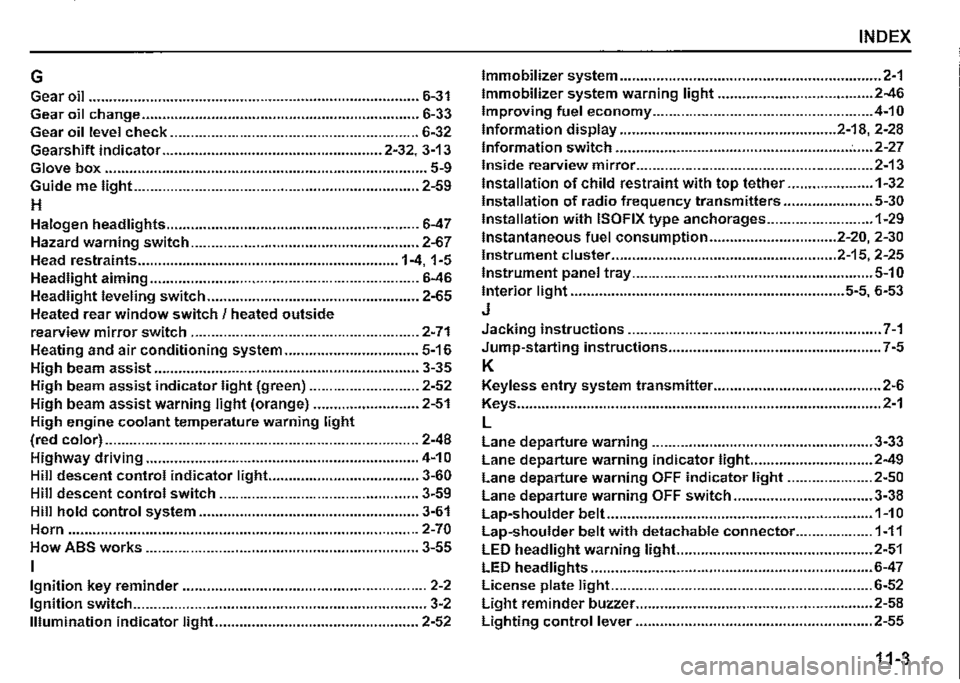
INDEX
G Immobilizer system ................................................................ 2-1
Gear oil ................................................................................. 6-31 Immobilizer system warning light ...................................... 2-46
Gear oil change .................................................................... 6-33 Improving fuel economy ...................................................... 4-10
Gear oil level check ............................................................. 6-32 Information display ..................................................... 2-18, 2-28
Gearshift indicator ...................................................... 2-32, 3-13 Information switch ......................................................... : ..... 2-27
Glove box ............................................................................... 5-9 Inside rearview mirror .......................................................... 2-13
Guide me light ...................................................................... 2-59 Installation of child restraint with top tether ..................... 1-32
H Installation of radio frequency transmitters ...................... 5-30
Halogen headlights .............................................................. 6-47
Hazard warning switch ........................................................ 2-67
Head restraints ................................................................ 1-4, 1-5
Headlight aiming .................................................................. 6-46
Headlight leveling switch .................................................... 2-65
Heated rear window switch / heated outside
Installation with ISOFIX type anchorages .......................... 1-29
Instantaneous fuel consumption ............................... 2-20, 2-30
Instrument cluster ....................................................... 2-15, 2-25
Instrument panel tray ........................................................... 5-10
Interior light ................................................................... 5-5, 6-53
J
rearview mirror switch ........................................................ 2-71 Jacking instructions .............................................................. 7-1
Heating and air conditioning system ................................. 5-16 Jump-starting instructions .................................................... 7-5
High beam assist ................................................................. 3-35 K
High beam assist indicator light (green) ........................... 2-52 Keyless entry system transmitter ......................................... 2-6
High beam assist warning light (orange) .......................... 2-51 Keys ......................................................................................... 2-1
High engine coolant temperature warning light L
(red color) ............................................................................. 2-48 Lane departure warning ...................................................... 3-33 Highway driving ................................................................... 4-1 O Lane departure warning indicator light.. ............................ 2-49
Hill descent control indicator light... .................................. 3-60 Lane departure warning OFF indicator light ..................... 2-50 Hill descent control switch ................................................. 3-59 Lane departure warning OFF switch .................................. 3-38 Hill hold control system ...................................................... 3-61 Lap-shoulder belt ................................................................. 1-1 O Horn ...................................................................................... 2-70 Lap-shoulder belt with detachable connector ................... 1-11 How ABS works ................................................................... 3-55 LED headlight warning light.. .............................................. 2-51
I LED headlights ..................................................................... 6-47
Ignition key reminder ............................................................ 2-2 License plate light ................................................................ 6-52
Ignition switch ........................................................................ 3-2 Light reminder buzzer .......................................................... 2-58
Illumination indicator light.. ................................................ 2-52 Lighting control lever .......................................................... 2-55
11-3
Page 414 of 421
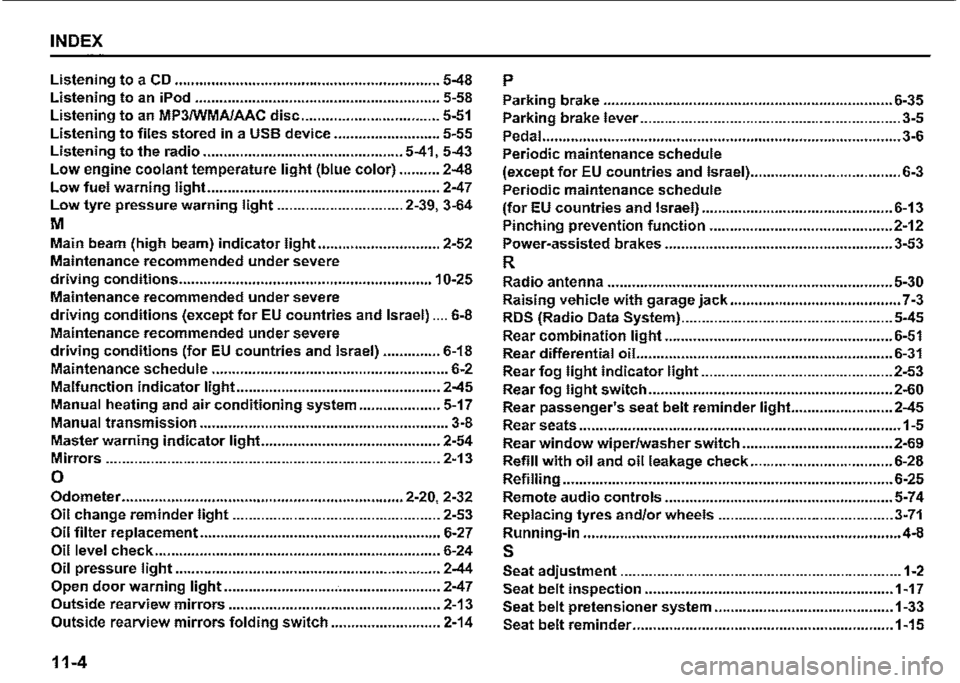
INDEX
Listening to a CD ................................................................. 5-48
Listening to an iPod ............................................................ 5-58
Listening to an MP3/WMA/AAC disc .................................. 5-51
Listening to files stored in a USB device .......................... 5-55
Listening to the radio ................................................. 5-41, 5-43
Low engine coolant temperature light (blue color) .......... 2-48
Low fuel warning light ......................................................... 2-47
Low tyre pressure warning light ............................... 2-39, 3-64
M
Main beam (high beam) indicator light .............................. 2-52
Maintenance recommended under severe
driving conditions .............................................................. 10-25
Maintenance recommended under severe
driving conditions (except for EU countries and Israel) .... 6-8
Maintenance recommended under severe
driving conditions (for EU countries and Israel) .............. 6-18
Maintenance schedule .......................................................... 6-2
Malfunction indicator light .................................................. 2-45
Manual heating and air conditioning system .................... 5-17
Manual transmission ............................................................. 3-8
Master warning indicator light ............................................ 2-54
Mirrors .................................................................................. 2-13
0
Odometer ..................................................................... 2-20, 2-32
Oil change reminder light ................................................... 2-53
Oil filter replacement ........................................................•.. 6-27
Oil level check ...................................................................... 6-24
Oil pressure light ...................................•.................•........... 2-44
Open door warning light ..................................................... 2-47
Outside rearview mirrors ..........................•......................... 2-13
Outside rearview mirrors folding switch ........................... 2-14
11-4
p
Parking brake ....................................................................... 6-35
Parking brake lever ................................................................ 3-5
Pedal ........•............................................................................... 3-6
Periodic maintenance schedule
(except for EU countries and lsrael) ..................................... 6-3
Periodic maintenance schedule
(for EU countries and Israel) ............................................... 6-13
Pinching prevention function ............................................. 2-12
Power-assisted brakes ........................................................ 3-53
R
Radio antenna ...................................................................... 5-30
Raising vehicle with garage jack .......................................... 7-3
RDS (Radio Data System) .................................................... 5-45
Rear combination light ........................................................ 6-51
Rear differential oil.. ............................................................. 6-31
Rear fog light indicator light ............................................... 2-53
Rear fog light switch ............................................................ 2-60
Rear passenger's seat belt reminder light... ...................... 2-45
Rear seats ............................................................................... 1-5
Rear window wiper/washer switch ..................................... 2-69
Refill with oil and oil leakage check ................................... 6-28
Refilling ................................................................................. 6-25
Remote audio controls ........................................................ 5-74
Replacing tyres and/or wheels ........................................... 3-71
Running-in .............................................................................• 4-8
s
Seat adjustment ..................................................................... 1-2
Seat belt inspection ............................................................. 1-17
Seat belt pretensioner system ............................................ 1-33
Seat belt reminder ................................................................ 1-15